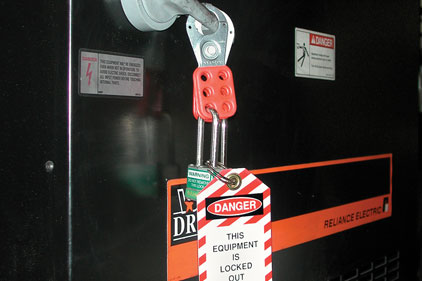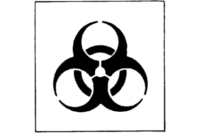Safeguarding
OSHA’s machine guarding standard states at 1910.212(a)(1): “Types of guarding. One or more methods of machine guarding shall be provided to protect the operator and other employees in the machine area from hazards such as those created by point of operation, ingoing nip points, rotating parts, flying chips, and sparks.”
Options
Machine safeguards include:
? Fixed barrier guards permanently attached to the machine
? Interlocked barrier guards automatically shut down the machine when opened.
? Adjustable barrier guards allow for various types and sizes of stock.
? Self-adjusting barrier guards automatically open or close depending on the movement of the stock.
? Interlocked gate guards move into place with each machine cycle. The equipment will not operate if they are not in position.
? Presence-sensing devices use a light curtain or a radiofrequency field that shuts off the machine when the beam is interrupted.
? Pullback and restraint devices use cables worn by the operator to keep him from reaching the point of operation.
? Safety trip control devices to quickly shut down the machine in case of an emergency.
? Two-hand control devices force the operator to keep his hands and arms in a safe area.
? Fixed or moveable shields guard operators and other workers from chips, splashes, sprays and sparks.
When using safeguarding devices instead of guards, it’s a good practice to use two or more devices or to supplement the device with a guard.
Additional protection can be provided by:
? Awareness barriers that warn employees to stay out of a hazardous area.
? Holding or handling tools to help the operator position stock.
? Machine location sufficient to prevent access to a machine’s hazardous areas.
Hazard assessment
Periodically assess all of your machines, even those with safeguards installed by the equipment’s manufacturer, to determine if additional safeguards are necessary due to how you use the equipment in your facility.
Lockout-tagout
It’s implied that machine guards protect workers during the equipment’s normal operation. LOTO is called for during machine servicing and maintenance.
The LOTO standard states at 1910.147(a) that it “covers the servicing and maintenance of machines and equipment in which the unexpected energization or start-up of the machines or equipment, or release of stored energy, could harm employees.” The standard “requires employers to establish a program and utilize procedures for affixing appropriate lockout devices or tagout devices to energy isolating devices, and to otherwise disable machines or equipment to prevent unexpected energization, start-up or release of stored energy...”.
The definition of “servicing and/or maintenance” at 1910.147(b) is: “Workplace activities such as constructing, installing, setting up, adjusting, inspecting, modifying, and maintaining and/or servicing machines or equipment.”
Lockout involves following an established machine-specific procedure to safely shut down a machine, disconnect it from its energy supplies, apply locks to energy control devices, and verify that the machine is shut down. When a machine is locked out, the machine safeguards can be removed and the equipment may be safely disassembled.
Lockout is the preferred method for energy control, but tagout is used if the machine’s energy isolation devices don’t accept a lock. Tagout follows the same procedures, but warning tags are applied instead of locks.
Tagout can also be used if the machine is able to be locked out, but you have to take additional steps to ensure full employee protection.
Minor servicing exception
The LOTO standard includes a provision that brings machine safeguards back into play.
If you’ve determined your operations meet the LOTO standard’s exception to 1910.147(a)(2)(ii) for minor tool changes and adjustments and other minor servicing activities that take place during normal production operations, then effective protection can be provided by machine safeguards. For example, guidance from OSHA indicates that an interlocked barrier guard is an effective control to meet the exception.
However, you must be certain your dependence on the machine safeguards meets OSHA’s expectations for when it’s appropriate to use the exception. OSHA provides guidance in chapter 3 section IV of its directive, CPL 02-00-147, The Control of Hazardous Energy — Enforcement Policy and Inspection Procedures, which includes the following:
“The first set of criteria for determining the application of the minor servicing exception is whether the activity must take place during, and is inherent to, normal production operations. These servicing activities must be necessary to allow production to proceed without interruption. Additionally, the minor servicing activity must be:
“A. Routine: The activity must be performed as part of a regular and prescribed course of procedure and be performed in accordance with established practices.
“B. Repetitive: The activity must be repeated regularly as part of the production process or cycle.
“C. Integral: The activity must be inherent to the production process.
“The employer must also demonstrate that the alternative measures provide effective protection from the hazardous energy. Most importantly, this exception applies only if each and every element of the exception is met.”


